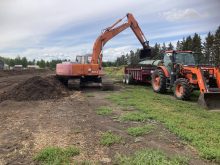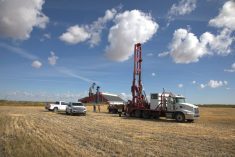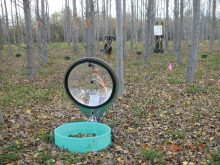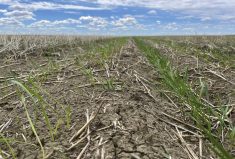Not very many hands go up when Mark Cutts asks a room full of producers how many of them test their soil every year.
“I don’t think the majority is doing soil testing,” said the crop specialist with Alberta Agriculture and Rural Development.
“If a producer is happy with his yields and he’s not soil testing — well, he’s happy with his yields. He doesn’t necessarily know he could have got another five bushels if he had changed his blend or done things a little differently.”
Read Also
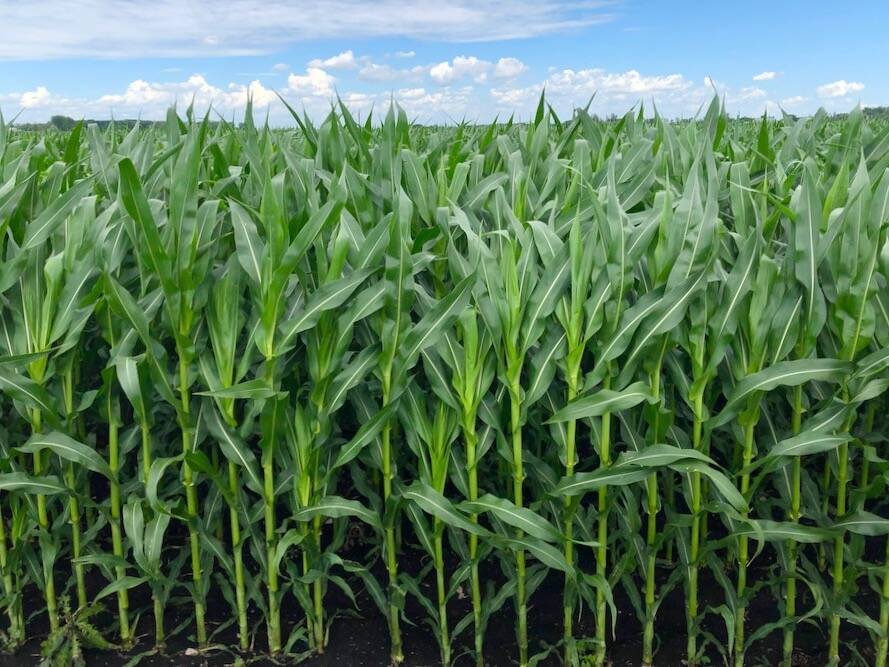
Nutrien pays farmers for efficient nitrogen
Nutrien’s Sustainable Nitrogen Outcomes (SNO) program pays Prairie farmers to limit nitrogen loss and, therefore, fertilizer-related greenhouse gas emissions.
That sort of additional yield translates into big bucks — but fewer than half of Alberta producers use soil tests to shape their fertility programs, said Cutts. Cost is one factor — a basic test runs from $20 to $50 — but producers tend to go with the blends they know, he said.
“Once producers get settled into some blends, they tend to run with those blends for a number of years,” he said. “There’s nothing wrong with that, but it’s probably not a bad idea every four or five years to collect some soil samples and see if nutrient levels are where you want them to be.”
“Things do change, and if you haven’t been replacing the nutrients at the same amount they’re being removed, that level may start to drop down.”
It’s all about finding the right balance.
“If you’re not applying enough, you’re potentially limiting yield,” said Cutts. “On the other hand, you don’t want to be overapplying them because then that’s money that’s not being put into yield.”
Fine tuning fertility

That’s what led producer Richard Limoges to begin “intensive” soil sampling in 2005.
“We use it to monitor our nutrient levels in order to identify opportunities to improve nutrients that will help us grow better crops,” said Limoges, who operates a 1,500-acre seed farm near McLennan with his father.
Typically, that means avoiding “the usual retail blends” and fine tuning the farm’s fertility program.
“It’s given us a better idea of our immobile nutrients, like phosphorus and potassium, and it’s allowed us to manage our nitrogen much better, which is the biggest cost for fertility on the farm,” said Limoges, who is also an Agri-Trend coach.
“It helps us allocate our fertilizer dollars better.”
The average amount of fertilizer he buys hasn’t changed much in the past decade, but the swing on a specific field can be dramatic in any given year.
“If we’re coming off a dry year, we might find a lot of residual nitrogen, which will really cut back our need for the next year,” he said. “After a wet year or a really good crop, we might have none and need to apply a lot more.”
One field in particular has benefited from soil testing, he said. In that field, the crops tend to lodge and stay green through harvest. The solution was to decrease nitrogen and boost phosphorus and potash.
And Limoges said he has “absolutely” seen a yield impact.
“It takes some time, but it’s worth it. There’s no question,” he said. “I wouldn’t farm without it now that I’ve been doing it.”
More is good
On Michael Kalisvaart’s farm, soil sampling is one extra step to making sure there’s “no gaps in (his) management.”
“Without a soil sample, you’re just flying blind,” said Kalisvaart, who has been soil sampling on his 12,000-acre grain farm near Gibbons for the past 20 years.
“We know how much nutrition we’re pulling out of the soil, and we need to know where we’re starting so that we can hit our yield targets. It’s given us great confidence that we’ve done everything that we can to have a successful year.”
And the results speak for themselves.
“I’m absolutely sure we have higher yields and that our yield averages across all our fields are higher than they would be otherwise, if we were just taking a guess,” he said. “It helps us control costs and be more accurate with what we use.”
Kalisvaart is now ramping up his sampling to integrate variable-rate fertilizer application into his operation.
“This year, for the first time, we’re doing about 35 per cent of our ground on either a 2.5- or five-acre grid,” he said. “We’re going from one composite sample of the whole field to a minimum of 30 samples and up to 60 samples per field.”
Using an AutoProbe system that hooks onto the back of his tractor, Kalisvaart was able to take soil samples every 11 feet.
“We’re getting really, really accurate soil tests just because of the number of times we poke the ground, and then of course, we’re getting these fantastic nutrition maps of our fields.”
It takes about three hours to collect 60 samples “versus one composite sample taking two hours roughly, if they do a good job,” he said.
He’s also reduced his costs by working with a network of other farmers — called FamilyFarms Group — to get a group rate.
“I did try and pursue a price for lab tests with a Canadian lab independent of retailers, and it did quote me significant savings as well but only with large volume,” he said.
“The lab test itself we are getting done for about a third of the price, with freight included.”
It’s a worthwhile investment, he added.
“When you’re spending the kind of money we do on fertilizer, I don’t see why you would do it any other way.”
Testing tips
More testing also helps weed out the ones that are out of whack.
“Because we have such a large number of samples on most of our fields, when we get a sample that’s a bit of a surprise, we can discount it because we know it isn’t following our trends,” said Kalisvaart.
That’s the trick to using soil tests successfully, said Cutts.
“If the recommendation comes in and it’s asking for 80 pounds of nitrogen on a barley crop and the producer knows that if he puts on over 70 pounds, that crop is going to lodge, he’s going to make some decisions using his own experience,” he said.
“Producers should not be afraid to tweak those numbers based on their own experiences.”
Limoges recommends producers also take a “systematic approach” to soil sampling — in other words, this is one area where free is not necessarily a good thing.
“A lot of retailers will offer free soil sampling, and there’s no continuity to it from last year, because they’re not asking the right questions,” he said. “They’re still offering the guy the same blend that he took home last year, regardless of the soil test.”
In addition to current crop and yield goals, producers need to consider past crop types, fertility, and yields if they hope to make the most of their soil samples, said Limoges.
“I think that’s where people drop the ball. You can’t get a good recommendation without the background.”



